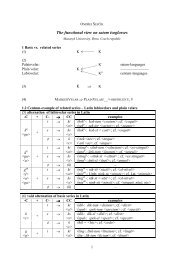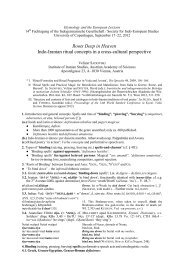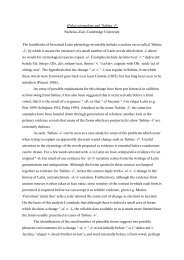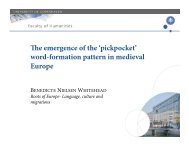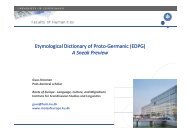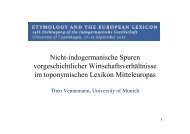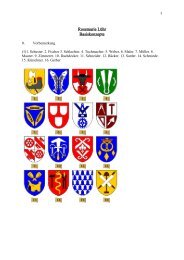Indo-European singulatives - Etymology and the European Lexicon
Indo-European singulatives - Etymology and the European Lexicon
Indo-European singulatives - Etymology and the European Lexicon
Create successful ePaper yourself
Turn your PDF publications into a flip-book with our unique Google optimized e-Paper software.
<strong>Etymology</strong> <strong>and</strong> <strong>the</strong> <strong>European</strong> <strong>Lexicon</strong>, Copenhagen, 17 September 2012<br />
<strong>Indo</strong>-<strong>European</strong> <strong>singulatives</strong><br />
Tijmen Pronk, Institut za hrvatski jezik i jezikoslovlje, tpronk@ihjj.hr<br />
1. <strong>Indo</strong>-<strong>European</strong> n-stems<br />
Derive an individual from an adjective, e.g. Gr. Στράβων PN, lit. ‘squinter’, Οὐρανίωνες ‘heavenly<br />
ones’, Gr. Πά̄ν TN, Skt. pūṣán- TN, lit. ‘<strong>the</strong> herding, protecting one’ < *p(e)h2-us-n-, Av. marətan-<br />
‘mortal’, Lat. Catō PN, lit. ‘<strong>the</strong> clever one’, OIr. marbán ‘dead person’, cáechán ‘blind person’, Goth.<br />
weiha ‘priest’, Lith. pirmuõ ‘first-born’.<br />
Derive a ‘person pertaining to, of <strong>the</strong>’ from a noun, e.g. Lat. homō ‘man’, OHG ōstara ‘spring<br />
goddess’, Lith. sesernas ‘sister’s son’, Lat. dominus ‘master of <strong>the</strong> house’, Goth. þiudans ‘king’.<br />
Grammatical functions:<br />
Germanic: definite adjectives.<br />
Greek: comparatives in -ιων < *-is-ōn.<br />
Tocharian: marker of rational beings.<br />
Pontic Greek: definite form of masculine o-stems: o fílon, gen. ti fílonos ‘<strong>the</strong> friend’.<br />
The n-stems also derive <strong>singulatives</strong> from collectives <strong>and</strong> duals denoting natural pairs.<br />
2. Celtic singulative n-stems<br />
Celtic has a suffix *-Vn(n)-io/ā that forms <strong>singulatives</strong> derived from a collective:<br />
OIr. grán (n.) ‘grain’, grá(i)nne (f.) ‘a grain’, glaine (f.) ‘jaw’, glainine ‘a jaw(bone)’, folt (m.) ‘hair’,<br />
foiltne ‘a hair’, Welsh adar ‘birds’, ederyn (m.) ‘a bird’, calaf ‘reed’, celevyn (m.) ‘a reed’, tywys ‘ears of<br />
corn’, tywysen (f.) ‘a corn ear’ etc.<br />
The vowel of <strong>the</strong> suffix can be -i- or -e-. Traditionally compared it to <strong>the</strong> adjectival appurtenance<br />
suffix *-in- (Gr. -ιν-, Lith., OPr., Lat. -in-, OCS -ьn-). More likely: formations in -ne derive from an<br />
n-stem, cf. OIr. asna 'rib' < *astVn-, MW assen, pl. eis from <strong>the</strong> root-noun in MW ascurn, MB ascorn<br />
'bone'.<br />
The singulative suffix reflects an n-stem enlarged with *-o-.<br />
3. Armenian singulative n-stems<br />
Armenian akn ‘eye’, jeṙn ‘h<strong>and</strong>’, otn ‘foot’, duṙn ‘door, gate’, <strong>singulatives</strong> to plural ač‘k‘, jeṙk‘, otk‘,<br />
durk‘. Cf. also unkn ‘ear’, virtually exclusively singular.<br />
1<br />
Traditional explanation: acc.sg. of a root-noun in -, cf. ewtcn ‘seven’ < *sept But PIE *h3ekw- ‘eye’<br />
was neuter <strong>and</strong> *duor- a duale or plurale tantum.<br />
Reanalysis of <strong>the</strong> suffix as -kn: akn ‘eye’ (with *kcn > kn) ⇒ unkn ‘ear’, armukn ‘elbow’ ⇒ jukn ‘fish’,<br />
mukn ‘mouse’.<br />
4. <strong>Indo</strong>-<strong>European</strong> singulative body parts (selection)<br />
Celtic has <strong>singulatives</strong> to collectives, Armenian has <strong>singulatives</strong> to duals denoting a natural pair. In<br />
o<strong>the</strong>r branches <strong>the</strong>re is a frequent pattern of n-stem forms next to o<strong>the</strong>r formations for nouns that<br />
typically refer to a collective or dual.<br />
‘eye’ <strong>and</strong> ‘ear’<br />
Arm. akn ‘eye’, unkn ‘ear’, Goth. augo ‘eye’, OCS okъno ‘window’ < *-n̥-, Goth. auso, Gr. οὖς, gen.<br />
οὒατος ‘ear, h<strong>and</strong>le’.<br />
‘knee’<br />
OIr. glún, W -glin, Alb. gjun, Gr. γόνυ, gen. γόνατος, γούνατος next to γουνός (Homer). Celtic <strong>and</strong><br />
Albanian show (independent) dissimilation of n...n to l...n. The Celtic long vowel must be explained<br />
from <strong>the</strong> dual *-uh1. Greek adapted to <strong>the</strong> r/n-stems.<br />
‘eyebrow’<br />
ON brūn ‘edge’ < *bhruH-n-<br />
Lith. dial. birvė ‘eyebrow’ < *bhr̥u̯-ēn, Žemaitian brùnė ‘eyebrow, back of a knife or razor’, Lith.<br />
briaunà (4) ‘edge’, OCS brьvъno, brъvъno ‘beam’.<br />
Cf. *bhruH-: ToB pärwāne, Skt. bhr-, Gr. ὀφρῦς, OE brū, Lith. bruvìs, dial. brùvė, CS brьvь<br />
‘eyebrow’.<br />
The Baltic forms preclude a laryngeal. Two options:<br />
- u-stem *bhrh1-u- (cf. Gaul. briua ‘bridge’, OHG brāwa ‘eyebrow’ < *bhreh1-u-?) - dual. *bhru-h1 / collective *bhru-h2- next to singulative *bhru-n-. ‘arm’ <strong>and</strong> ‘shoulder’<br />
Vedic dós, (ŚB) gen.sg. doṣṇás 'forearm' (adapted to <strong>the</strong> r/n-stems).<br />
ToA poke, B (obl.) pokai, (gen.) pokantse ‘arm’ (n-stem), cf. Gr. πῆχυς, Skt. bāhú- ‘forearm’<br />
Polish ramię, Rus. ramená (pl.) ‘shoulder’ < *-m-en-, cf. OCS ramo, Skt. īrmá-, Lat. armus < *-mo.<br />
2
‘nail’<br />
OIr. ingen (f.) ‘nail, claw’, OW, OBret. eguin < *angwīnā < *h3nghu-ēn-eh2, cf. Lat. unguis, ToA maku<br />
‘nails’, Gr. ὄνυξ ‘claws’ < *h3nghu-. The formation is identical to that of OIr. uilen (f.), OW pl. elinou, MBret. elin ‘elbow’ < *h3el-ēn-eh2.<br />
Arm. ełungn ‘nail’ (details unclear)<br />
5. Vedic i/n-heteroclitics<br />
Vedic ákṣi, gen. sg. akṣṇás 'eye' (cf. akṣaṇvánt- ‘having eyes, seeing’), sákthi, nom.pl. sakthni 'thigh',<br />
ásthi, gen. sg. asthnás 'bone' (cf. Av. astəntāt- ‘corporeality’)<br />
The aspirate of sákthi <strong>and</strong> ásthi points to *-h2, ákṣi ‘mountain’, singulative *gwer-h2-n- ‘rock, stone’, adj. *gwer-h2-u- ‘heavy’ (earlier *gwer-u-), contamination to *gwer-h2-n-u- <strong>and</strong> *gwer-h2-u-n-. 7. ‘horn’<br />
singulative: *ḱer-n- (to an old dual?):<br />
Latin cornum ‘horn’, W. carn ‘hoof’, Go. haurn ‘horn’, MW ascurn 'bone' < *ast-ḱor-n-, Skt. śŕ̥ṅga-<br />
‘horn’, OHG (h)rind, ‘horned animal’, OE hrȳðer ‘cow’, probably also MW cern ‘corner, jaw, cheek,<br />
side’, HLuw. suran- ‘horn’<br />
3<br />
collective *ḱer-h2-:<br />
Gr. κάρᾱ ‘head’, Myc. qo-u-ka-ra ‘ox-headed’<br />
u-stem *ḱer-h2-u-:<br />
Gr. κεραός ‘horned’, δίκροος ‘forked’, Lith. kárvė, CS krava, Pol. dial. karw ‘cow’, OPr. curwis ‘ox’,<br />
sirwis ‘doe’, Lat. cervus, W carw, OHG hiruz ‘deer’. Also Av. srū-, sruuā- ‘nail, horn’, OIr. cruë<br />
‘hoof’ with laryngeal meta<strong>the</strong>sis?<br />
s-stem *ḱer-h2-s-:<br />
Vedic śíras- ‘head, top’, Av. sarah- ‘head’, Gr. κέρας ‘horn (for blowing <strong>and</strong> drinking)’, Myc. ins.pl.<br />
ka-ra-a-pi /krāhaphi/, Arm. sar ‘top, tip, summit’ (if not from Iranian), Lat. cerebrum ‘brain’, Gr.<br />
κάρᾱ, gen.sg. κρᾱάτος ‘head’, κρᾱνίον ‘skull, brain-pan’, κάρηνα (n.pl.) ‘heads, tops’, ON hjarni,<br />
MDu. hersene ‘brain’, ON hjarsi ‘skull’.<br />
The forms deriving from an n-stem are originally <strong>singulatives</strong>.<br />
Conclusion<br />
Proto-<strong>Indo</strong>-<strong>European</strong> formed <strong>singulatives</strong> by deriving an n-stem from a root or stem. The original<br />
situation is best preserved in Celtic, <strong>the</strong>re are relics in Armenian.<br />
All major branches of <strong>Indo</strong>-<strong>European</strong> (except perhaps Anatolian) contain n-stems or derivatives that<br />
go back to such <strong>singulatives</strong>. The most prominent examples are body parts, most of which come in<br />
pairs, <strong>and</strong> <strong>the</strong> words for ‘(mill)stone’ <strong>and</strong> ‘horn’.<br />
References<br />
Beekes, R. 1987 “PIE neuter i-stems”, FS Henry Hoenigswald, 45-56.<br />
De Bernardo-Stempel, P. 1999 Nominale Wortbildung des älteren Irischen. Stammbildung und Derivation. Tübingen.<br />
Hamp, E. 1994 “The laryngeal heteroclites” FS Karl Horst Schmidt, 35-40.<br />
Kortl<strong>and</strong>t, F. 2003. Armeniaca: comparative notes. Ann Arbor.<br />
Lambert, P.-Y. 1978 “Restes de la flexion hétéroclitique en Celtique?”, FS Michel Lejeune, 115-122.<br />
Malzahn, M. 2001 S<strong>and</strong>hiphänomene im Rigveda als Reflexe von Archaismen und Dialektismen. Vienna, unpubl. diss.<br />
Marstr<strong>and</strong>er, C. 1910 “Hibernica”, Zeitschrift für celtische Philologie 7: 357-418.<br />
Martirosyan, H. 2010 Etymological dictionary of <strong>the</strong> Armenian inherited lexicon. Leiden-Boston.<br />
Matasović, R. 2009 Etymological Dictionary of Proto-Celtic. Leiden-Boston.<br />
Meillet, A. 1892 “Notes Arméniennes”, MSL 8, 153-165.<br />
Meillet, A. 1903 “Varia”, MSL 12, 213-238.<br />
Meillet, A. 1925 “Le nom indoeuropéen de la meule”, FS Paul Boyer, 1-12.<br />
Nussbaum, A. 1985 Head <strong>and</strong> Horn in <strong>Indo</strong>-<strong>European</strong>. Berlin-New York.<br />
Olsen, B. 1999 The noun in Biblical Armenian. Berlin-New York.<br />
Winter, W. 2005 Kleine Schriften, Selected Writings, in zwei Bänden. Bremen.<br />
4


